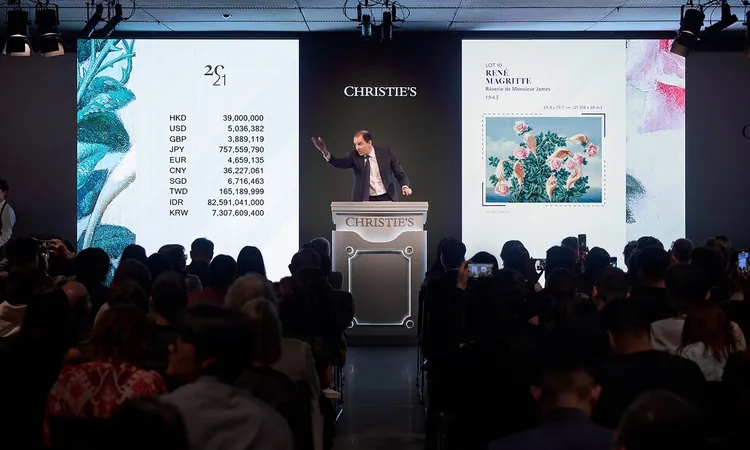
Hong Kong's Auction Showdown: Christie's and Sotheby's Achieve Strong Results Amidst Challenging Times
2025-03-31
Author: Jessica Wong
Last week in Hong Kong, the renowned auction houses Christie's and Sotheby's engaged in an exciting competition, aligning their sales with the vibrant Art Basel fair for the first time. This strategic timing injected considerable energy into the auction rooms, offering a much-needed boost in a challenging art market.
While both houses presented less extensive evening sales compared to their previous visits—Christie’s in September and Sotheby’s in November—they managed to deliver solid totals that fell within estimated ranges. This performance indicates that local collectors, particularly from China, remain active participants in the market, even if they are not spending at the levels observed in the past.
The auction houses' distinctive strategies came to the forefront during this week. Christie's operated from the stylish Henderson Building, creating an atmosphere of hushed elegance adorned with corporate white orchids and stunning city views. Meanwhile, Sotheby's showcased a more public-facing approach in the Landmark Building, featuring upscale showrooms that mirror the luxury fashion realm. Their lower-level auction space, with its dim lighting and modern aesthetic, evokes the intriguing vibe of a nightclub.
On March 28, Christie's auction featured 41 lots that generated a total of HK$457.3 million (HK$560 million including fees), although the sale faced challenges with two works withdrawn and two remaining unsold. The following evening at Sotheby’s, 42 lots fetched a total of HK$236.9 million (HK$297.6 million including fees), but also grappling with four withdrawn lots and two unsold pieces. In stark contrast, previous auctions saw totals of $1 billion and $410 million, underlining a shift in market dynamics.
The distinction between the two auction houses became evident through the performance of their featured lots. Sotheby’s highlighted Marc Chagall's vibrant piece *Fleurs de printemps (La Cruche aux fleurs de printemps)* (1930), which sold for its maximum estimate of HK$28 million after vigorous bidding from multiple parties. Conversely, Christie's showcased Jean-Michel Basquiat's iconic *Sabato por la Noche (Saturday Night)* (1984), which garnered HK$95 million—falling within the expected range but leaving room for speculation about its potential to reach higher.
Interestingly, the once-popular works of Chinese modernists are experiencing a downturn, reflecting broader economic shifts. At Christie's, a work by Zao Wou-Ki sold at HK$40 million, showcasing the reduced appetite for high-end pieces compared to their peak years. In contrast, the auction scene also revealed promising signs of support for Southeast Asian artists, who saw significant bids surpassing estimates, like Mai Trung Thu’s works that drew competitive offers.
Overall, despite the hurdles faced within the Hong Kong art market, last week's auctions created a sturdy foundation for the future. Advisor Patti Wong noted significant positive energy during Art Basel Hong Kong, citing improvements in both offerings and attendance. This enthusiasm seemed to spill over into the auction arena, with impressive sell-through rates that may signal a revival of international consignments—a crucial step for the auction houses' continued success in the region.
Branczik's reflection encapsulates the sentiment: "While it was a tricky season to secure quality offerings, the scene in Hong Kong is fostering a renewed sense of optimism." The auction houses may still have work ahead, but the prospects are looking brighter, hinting at a resilient comeback in the Hong Kong art market.


 Brasil (PT)
Brasil (PT)
 Canada (EN)
Canada (EN)
 Chile (ES)
Chile (ES)
 Česko (CS)
Česko (CS)
 대한민국 (KO)
대한민국 (KO)
 España (ES)
España (ES)
 France (FR)
France (FR)
 Hong Kong (EN)
Hong Kong (EN)
 Italia (IT)
Italia (IT)
 日本 (JA)
日本 (JA)
 Magyarország (HU)
Magyarország (HU)
 Norge (NO)
Norge (NO)
 Polska (PL)
Polska (PL)
 Schweiz (DE)
Schweiz (DE)
 Singapore (EN)
Singapore (EN)
 Sverige (SV)
Sverige (SV)
 Suomi (FI)
Suomi (FI)
 Türkiye (TR)
Türkiye (TR)
 الإمارات العربية المتحدة (AR)
الإمارات العربية المتحدة (AR)